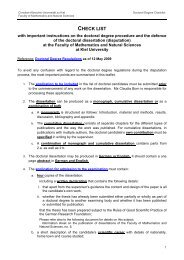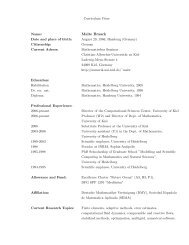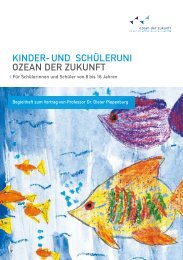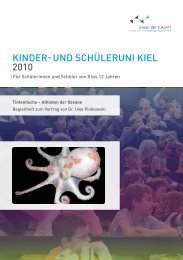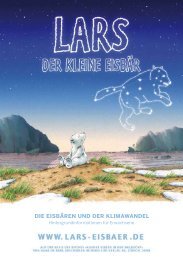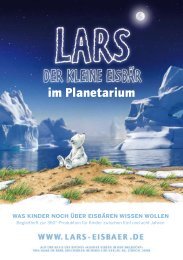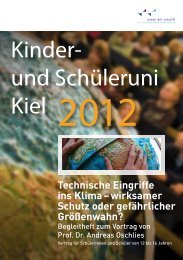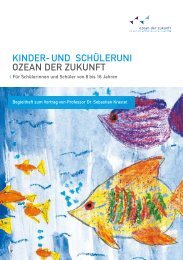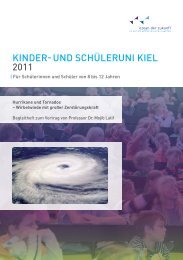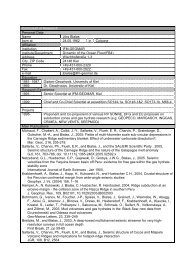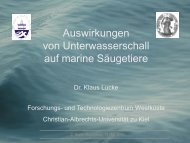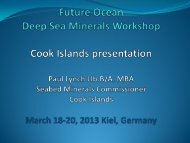Untitled - The Future Ocean
Untitled - The Future Ocean
Untitled - The Future Ocean
- No tags were found...
You also want an ePaper? Increase the reach of your titles
YUMPU automatically turns print PDFs into web optimized ePapers that Google loves.
(4) a determination of the impact of anthropogenic climate changes, such as higher stratificationand lower levels of mixing, more frequent El Niño episodes, the slowing of Atlantic overturning, adecrease in Arctic sea ice, etc., on oceanic CO 2 uptake and marine biogeochemical cycles.<strong>The</strong> A3 ocean modeling program is closely related to the climate modeling in A4; together theseprojects will contribute to various other Cluster projects by providing model simulations of the earthsystem, quantifying the natural variability and range of future changes in various physical andbiogeochemical properties (e.g., circulation, temperature, CO 2 uptake), as required in A1, A2, A5,A7 and B1. A3 research will heavily rest on the infrastructure and tools provided by researchplatform P1 and interact with the observing system capabilities provided by P4; together with A4 itwill contribute to the development of the comprehensive “Kiel Climate Model System” provided andmaintained through P1.5. ReferencesAumont O, Orr JC, Monfray P, Madec G, Maier-Reimer E (1999) Nutrient trapping in the equatorialPacific: <strong>The</strong> ocean circulation solution. Glob. Biochem. Cycles 13, 351-370.Doney SC et al. (2004) Evaluating global ocean carbon models: <strong>The</strong> importance of realisticphysics. Glob. Biochem. Cycles 18 (GB3017).Eden C, Oschlies A (2006) Adiabatic reduction of circulation-related CO 2 air-sea flux biases in aNorth Atlantic carbon-cycle model. Glob. Biochem. Cycles, in press.Fasham MJR, Evans GT (1995) <strong>The</strong> use of optimization techniques to model marine ecosystemdynamics at the JGOFS station at 47N, 20W. Phil. Trans Roy. Soc. (B) 348(1324).Maier-Reimer E, Hasselmann K (1987) Transport and storage of CO 2 in the ocean - an inorganicocean-circulation carbon cycle model. Clim. Dynamics 2 (2), 63-90.LeQuere C, Orr JC, Monfray P, Aumont O, Madec G (2000) Interannual variability of the oceanicsink of CO 2 from 1979 to 1997. Glob. Biochem. Cycles 14, 247-265.Orr JC et al. (2001) Estimates of anthropogenic carbon uptake from four threedimensional globalocean models. Glob. Biochem. Cycles 15(1), 43-60.Oschlies A, Schartau M (2005) Basin-scale performance of a locally optimized marine ecosystemmodel. Journal of Marine Research (63/2), 335-358.Sabine C et al. (2004) <strong>The</strong> oceanic sink for anthropogenic CO 2 . Science 305 (5682).Schartau M, Oschlies A, Willebrand J (2001) Parameter estimates of a zero-dimensionalecosystem model applying the adjoint method. Deep Sea Research II 48, 1769-1800.Tanhua T, Biastoch A, Körtzinger A, Lüger H, Böning C, Wallace DWR (2006) Changes ofanthropogenic CO 2 and CFCs in the North Atlantic 1981-2004. Glob. Biochem. Cycl.(accepted).Wanninkhof R et al. (1999) Comparison of methods to determine the anthropogenic CO 2 invasioninto the Atlantic <strong>Ocean</strong>. Tellus 51B, 511-530.Wetzel P, Winguth A, Maier-Reimer E (2005) Sea-to-air CO 2 flux from 1948 to 2003: A modelstudy. Global Biogeochem. Cycles 19, GB2005, doi:10.1029/2004GB002339.44



